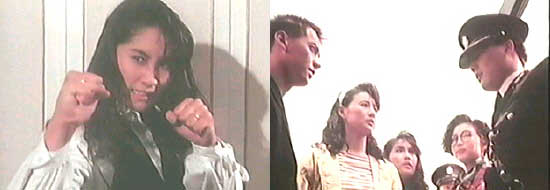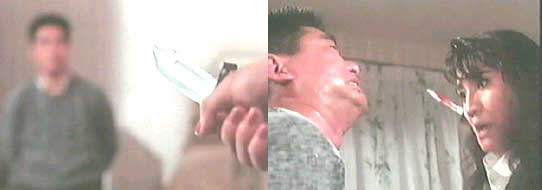
1989 - 1991
“Killer Angels” (1989)
(Jia’s Motion Picture Co. H.K., Dir. Lu Chin-ku)
Justifiably considered one of the best GWG
films, “Killer Angels” is primarily a showcase for Moon Lee. However,
the English-language dubbed version has edited out her entire nightclub
act. This omission is damaging, since Lee’s spectacular costume and
energetic performance help explain the allure of her character for Gordon
Lau’s assassin – a central sub-plot axis of the film. Lee heads an
undercover task force investigating the abduction and commercial trading
of women by a nightclub owner. To this end she secures a job as a
nightclub singer, but does not anticipate the infatuation of “Michael,”
the boss’s bodyguard and enforcer (Gordon Lau), who is instrumental in
first securing her employment, then shielding her from the malevolent attention
of his erstwhile girl friend (Nadeki). Appearing here in her first
significant HK action role, Nadeki was so impressive – both physically
and by exuding a dark, menacing screen presence – that she was mistaken
for Yukari Oshima in at least one database.
 Although clearly a supporting role, Nadeki’s part
is substantially more than a cameo. She appears in a number of action
sequences, riding a motorcycle and using a shotgun on her father’s opponents
(led by Ng Man-tat). Highlights include an explosive martial arts
confrontation in her father’s nightclub – displaying her peak physical
conditioning and kicking ability. She also pursues Moon Lee on her
motorcycle, culminating in a well-choreographed duel between them that
shows off her light, agile precision. When the police arrive, Nadeki
takes off running, melting into the background ninja-style. Wearing
stylish motorcycle leathers as well as an incongruous shirt frill, Nadeki
cuts a striking figure. She postures and glowers, eventually delivering
a vicious bite to Michael. When she springs a trap for the informant
who is assisting Lee’s investigation and his police escorts, Nadeki utters
a line (“Kill the asshole!”) that sums up her character’s mentality – mean,
efficient and unforgiving. This contrasts with her youthful facial
appearance and fringe of hair across her forehead – attributes of physical
appearance that would change quite markedly in subsequent parts.
Although clearly a supporting role, Nadeki’s part
is substantially more than a cameo. She appears in a number of action
sequences, riding a motorcycle and using a shotgun on her father’s opponents
(led by Ng Man-tat). Highlights include an explosive martial arts
confrontation in her father’s nightclub – displaying her peak physical
conditioning and kicking ability. She also pursues Moon Lee on her
motorcycle, culminating in a well-choreographed duel between them that
shows off her light, agile precision. When the police arrive, Nadeki
takes off running, melting into the background ninja-style. Wearing
stylish motorcycle leathers as well as an incongruous shirt frill, Nadeki
cuts a striking figure. She postures and glowers, eventually delivering
a vicious bite to Michael. When she springs a trap for the informant
who is assisting Lee’s investigation and his police escorts, Nadeki utters
a line (“Kill the asshole!”) that sums up her character’s mentality – mean,
efficient and unforgiving. This contrasts with her youthful facial
appearance and fringe of hair across her forehead – attributes of physical
appearance that would change quite markedly in subsequent parts.
 Nadeki’s character is betrayed not once but twice
by Michael, who intervenes to save Moon Lee when Nadeki has her in her
sights. When Nadeki ultimately turns on him, she nevertheless hesitates
to shoot – the momentary sentiment proving fatal. The film’s climax
– an extended assault on the triad compound by Moon Lee’s team of three
policewomen armed with automatic weapons – is a classic Moon Lee finale
of exaggerated gunplay and hyperkinetic martial arts. The romantic
interest between the assassin and policewoman is both implausible and sentimental,
but it is a measure of this genre film’s success that these aspects doe
not detract from the narrative. Plentiful action and ample display
of genre conventions sustain the pace. The Cantonese (non-subtitled)
version provides both better print quality and is more complete than the
English dub.
Nadeki’s character is betrayed not once but twice
by Michael, who intervenes to save Moon Lee when Nadeki has her in her
sights. When Nadeki ultimately turns on him, she nevertheless hesitates
to shoot – the momentary sentiment proving fatal. The film’s climax
– an extended assault on the triad compound by Moon Lee’s team of three
policewomen armed with automatic weapons – is a classic Moon Lee finale
of exaggerated gunplay and hyperkinetic martial arts. The romantic
interest between the assassin and policewoman is both implausible and sentimental,
but it is a measure of this genre film’s success that these aspects doe
not detract from the narrative. Plentiful action and ample display
of genre conventions sustain the pace. The Cantonese (non-subtitled)
version provides both better print quality and is more complete than the
English dub.

A 2.5, B3, C4, D4, E4, F3 (20.5)
Highly recommended
“Mission of Condor” (aka “Mission Kill,” 1990)
(D&B Films/Betaview Productions, Dir. Lee
King)
Successful casting combinations are often repeated
in HK action films. “Mission of Condor” was Nadeki’s second appearance
opposite Moon Lee, and the first of four with Ken Lo. Once again,
Moon Lee is the central character playing a detective who breaks a major
drug smuggling operation. This prompts a series of revenge killings,
contracted by a gang boss played to the hilt by Simon Yam. Nadeki
and Ken Lo play a pair of contract assassins. In this role Nadeki
has perhaps the closest approximation to a conventionally sensual or romantic
part – involving a glimpse of her bathing following an assassination then
putting on a rather close fitting black dress, and brief physical intimacy
with her partner Ken Lo. Otherwise, her character is all business.
Clad mostly in functional pants, loose blouse or shapeless topcoat, she
develops the look that would define most of her roles. Nuances, however,
are suggestive. In this film her white blouse has unusual bindings
on the arms – and a combat knife concealed up the sleeve. Nadeki
displays some knife fighting form in this film, in addition to some more
brief but excellent footwork.
 After the first assassin (Eddie Ko) fails to perform
a hit on the detectives (now aided by Max Mok playing an American FBI operative)
and is captured, Nadeki’s character is sent to finish the job. She
ruthlessly knifes Ko’s character to death, then fights with Moon Lee.
However, her finger is cut off as punishment for apparently failing the
mission. Later, after her partner is killed in a double-cross, she
switches allegiance and joins an attack on the gang hideout. There
she has a brief but impressive fight with Simon Yam that includes several
quite remarkable jumping kicks, as well as fatalistic determination.
This precedes the final confrontation between Moon Lee and Simon Yam that
is the film’s finale.
After the first assassin (Eddie Ko) fails to perform
a hit on the detectives (now aided by Max Mok playing an American FBI operative)
and is captured, Nadeki’s character is sent to finish the job. She
ruthlessly knifes Ko’s character to death, then fights with Moon Lee.
However, her finger is cut off as punishment for apparently failing the
mission. Later, after her partner is killed in a double-cross, she
switches allegiance and joins an attack on the gang hideout. There
she has a brief but impressive fight with Simon Yam that includes several
quite remarkable jumping kicks, as well as fatalistic determination.
This precedes the final confrontation between Moon Lee and Simon Yam that
is the film’s finale.
 Structurally, there are resemblances between “Mission
of Condor” and “Killer Angels.” In both Moon Lee was teamed with
other physically talented female partners, as well as a potential male
romantic interest. Her detective team was ranged against a ruthless
triad adversary who employed Nadeki and a male partner as enforcers.
In both films Nadeki’s character is coldly efficient but also loyal, and
it is this element of loyalty that proves fatal. As with another
pair of Moon Lee films that co-starred Yukari Oshima (“Dreaming the Reality,”
“Angel Terminators II”), the role of the female Japanese martial artist
was ambiguous and ultimately sacrificial. It is intriguing to speculate
on the apparent links between martial arts skills, gender, national origin
and perceive role attributes in these genre films. The consistency
with which these elements co-vary seems deliberate.
Structurally, there are resemblances between “Mission
of Condor” and “Killer Angels.” In both Moon Lee was teamed with
other physically talented female partners, as well as a potential male
romantic interest. Her detective team was ranged against a ruthless
triad adversary who employed Nadeki and a male partner as enforcers.
In both films Nadeki’s character is coldly efficient but also loyal, and
it is this element of loyalty that proves fatal. As with another
pair of Moon Lee films that co-starred Yukari Oshima (“Dreaming the Reality,”
“Angel Terminators II”), the role of the female Japanese martial artist
was ambiguous and ultimately sacrificial. It is intriguing to speculate
on the apparent links between martial arts skills, gender, national origin
and perceive role attributes in these genre films. The consistency
with which these elements co-vary seems deliberate.
A 2.5, B 4, C 4, D 4, E 4, F 3 (21.5)
Highly recommended
“Crystal Hunt” (1991)
(Cheung Yau Production Co., Dir. Tsui Pak-lam)
This is a film that does not take itself too
seriously yet manages to deliver genre conventions of satisfying quality
and quantity. Nadeki has considerable screen time and essentially
co-stars with Donnie Yen. The plot revolves around a four-way contest
to gain control of a magic crystal ensconced in a cave in the Thai mountains.
The exceptional powers of this stone are sought by the character of Carrie
Ng to heal her chronically ill father. She is aided by a devoted
bodyguard played by Ken Lo. Not only do they make a strikingly attired
couple, but Ng also participates in the fight scenes to an unusual extent.
The crystal is also sought by a gang of antiquities smugglers led by John
Salvitti and Michael Woods. They kidnap the father of Nadeki’s character
“Winnie” – an expert on antiquities – to help their quest. Donnie
Yen plays an “ex” – ex-boyfriend to Winnie, ex-cop and ex-partner to Sibelle
Hu. She, as usual, represents the presence of justice in pursuit
of the gang.
 Aided by some colorful supporting characters,
these various groups clash repeatedly in a series of well-choreographed
martial arts duels and gun battles, culminating in a final showdown outside
the cave where the crystal is located. The sheer number of high-caliber
martial artists ensures that some of the combat sequences are of outstanding
quality, while there is ample posing and spectacle at other points to maintain
interest. Nadeki has two major fight sequences – both excellent.
The first is set in Winnie’s residence where she is confronted by Ken Lo
and his assistants. In the second, she fights Michael Woods and members
of his gang. The first of these fights is particularly impressive,
Nadeki unloading a fearsome jumping back-kick. It’s all the more
striking for being accompanied by flying hair, red hose and a skin-tight
dress. Winnie subsequently transforms into a much grimmer figure
clad in combat clothing that characterizes her later parts. This
transformation is, itself, interesting.
Aided by some colorful supporting characters,
these various groups clash repeatedly in a series of well-choreographed
martial arts duels and gun battles, culminating in a final showdown outside
the cave where the crystal is located. The sheer number of high-caliber
martial artists ensures that some of the combat sequences are of outstanding
quality, while there is ample posing and spectacle at other points to maintain
interest. Nadeki has two major fight sequences – both excellent.
The first is set in Winnie’s residence where she is confronted by Ken Lo
and his assistants. In the second, she fights Michael Woods and members
of his gang. The first of these fights is particularly impressive,
Nadeki unloading a fearsome jumping back-kick. It’s all the more
striking for being accompanied by flying hair, red hose and a skin-tight
dress. Winnie subsequently transforms into a much grimmer figure
clad in combat clothing that characterizes her later parts. This
transformation is, itself, interesting.
 The choice role belongs to Donnie Yen, but the
film is also generous to the other players as well. All deliver spirited,
entertaining performances that place “Crystal Hunt” among the better films
of this genre. The action sequences are well choreographed and the
costuming is a separate visual pleasure throughout.
The choice role belongs to Donnie Yen, but the
film is also generous to the other players as well. All deliver spirited,
entertaining performances that place “Crystal Hunt” among the better films
of this genre. The action sequences are well choreographed and the
costuming is a separate visual pleasure throughout.

A 3, B 4, C 3, D 3, E 4, F 3 (20)
Highly recommended









